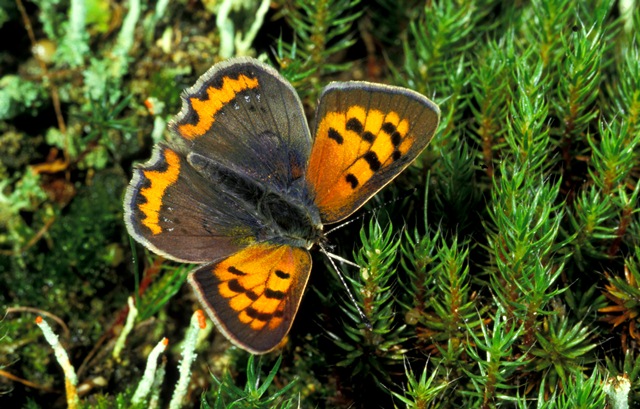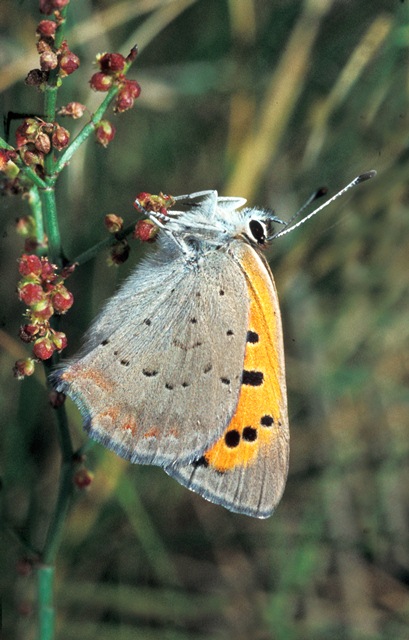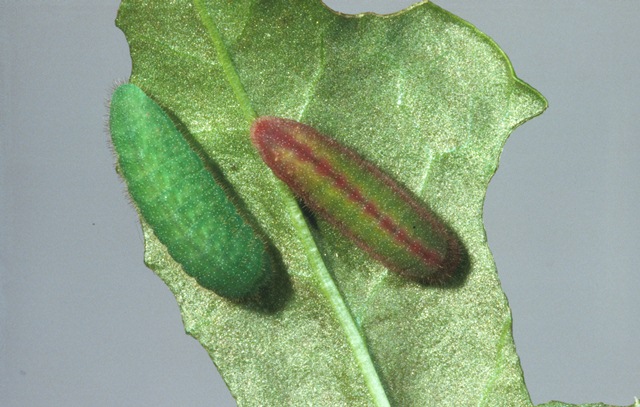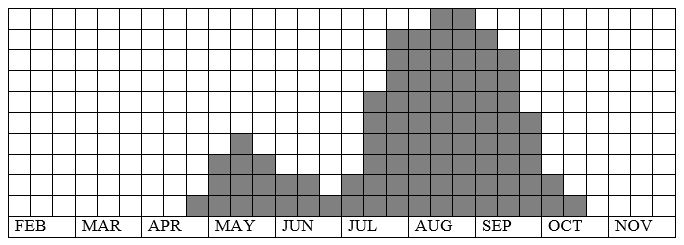|
32. Lycaena phlaeas (Linnaeus, 1761) / Small copper / Lycaenidae – Lycaeninae
NL: vuurvlindertje, kleine vuurvlinder / D: Kleiner Feuerfalter / F: cuivré, le bronzé
  
Photograph: Frits Bink, Rosita Moenen, Frits Bink ©.
Very small or small, wing length 13 (12-15) mm, male and female similar in appearance. It occurs everywhere in the Benelux and it is one of the most common species and can occur in salt-marshes, dunes, inland sand dunes and screes, heathland, grassland, coniferous woodland, meadows, countryside on roadside verges, railway banks, parks and gardens.
Butterfly is on the wing from early-May until early-October and peaks in mid-May and mid to end-August. The species occurs in subarctic and Mediterranean climates, its required heat sum is 300°d and the tolerated maximum 3000°d, the corresponding climate windows are 18 weeks and whole year open.
The well-developed traits of this species are spread in larval developing rate, the hardness from physical stress, the acceptance of a great variety of host-plant species and the exploration behaviour of the adult butterfly. In ecological point of view it is a stress-tolerated pioneer living in short grass vegetation.
Usually the butterflies are seen widely separate from each other, though sometimes in aggregation.
Ecological characteristics
Behaviour over time
Overwintering: young larva in second, third or fourth instar in the litter layer.
Reproduction: oviposition starts after 4-6 days when the body contains 76 (43-112) eggs, estimated potential production 2.1 times as much.
Larval feeding periods: nearly the whole year round, except when the vegetation is under snow and ice.
Generations: in temperate climate usually two, one to four in other climates.
Spreading of risk: flexibility in diapause, spread in time of larval development and nomadic behaviour of the adult.
Life cycle: egg 6 (4-10) days; larva 21 (14-35) days or 33 up to 43 weeks; pupa 12 (8-21) days.
Life span of adult: rather long, 3 weeks.
 
Photographs: Frits Bink ©.
Behaviour in space
From stay-at-home to migrant: nomad, spatial requirement modest.
Finding a mate: male perches, may stay up to two weeks at his pitch, female initiates courtship.
Orientation in the landscape: any site of short vegetation containing one of the host-plants.
Oviposition: on the underside of the leaf.
Defence
Threats from other organisms: no special defence, larvae occur in several colour forms. Larvae drop when disturbed.
Myrmecophily: very weak, ants may inspect the larvae for short periods.
Threats from the environment: larvae tolerant to physical stress.
Feeding habits
Adult: nectar, al kind of flowers in the short vegetation.
Larva: young larvae eat the parenchyma of the underside of the leaf, making small windows.
Larval foodplants
Plant species: Polygonaceae, Rumex acetosa, R. acetosella, R. conglomeratus, R. cripus, R. obtusifolius, R. scutatus, R. thersiflorus.
Journal
Rearing experiment based on specimen from national park Hoge Veluwe, Netherlands:
30 August 1985: female captured.
2 September: a few eggs laid.
3 September: more than 25 eggs laid.
10 September: eggs hatched.
19 September: larvae also ate the flowers.
24 September: larvae variable in size and colour: 7 were edged in red, 7 intermediate, 13 all green.
26 September: R. conglomeratus was accepted, larvae L4-5.
1 October: first pupa.
3 October: most larvae had pupated.
13 October: first adults emerged, two males.
15 October: 10 hatched, eight males and two females.
20 October: last one hatched.
21 October: first eggs of the new generation laid. Butterflies looked for shelter when temperature rose to 34°C.
Overwintering outdoors.
13 March 1986: larvae taken indoors, three L5 and three L4.
24 March: first one pupated.
21 April: first adult.
29 April 86: all adults hatched.
Table 32-1. Results of dissections

Table 32-2. Collection and observation localities
D, Borkener Paradies 52° 43’ 29”N – 7° 14’ 36”E; 9 July 2002.
D, Lorch 300m, 50° 02’ 05”N – 7° 47’ 56”E; 26 May 1986.
D, Meetschow 53° 02’ 32”N – 11° 23’ 32”E; 22 May 1984.
E, Canary Islands, La Gomera, Valle Gran Rey 28° 05’ 13”N – 17° 19’ 51”W; 2 March 1993, 12 March 1993.
F, Aurel, 400 m, 44° 43’N – 5° 16’E; 29 August 1984, 2 September 1984.
F, Brittany, Telgruc-sur- Mer 48° 12’ 25”N – 4° 22’ 25”W; 29 September 2004.
F, La Bruyère 45° 39’ 01”N – 5° 38’ 09”E; 25 August 1984.
F, la Grande Brière 47° 23’ 42”N – 2° 17’ 22”W; 24 September 2004.
F, Montmédy 217 m, 49° 31’ 07”N – 5° 21’ 33” E; 18 August 1984.
F, Vosges, Katzenkoepfle, 565m, 48° 01’ 54”N – 7° 06’ 04”E; 21 August 1984.
F, Vosges, Wasserbourg, 500 m, 48° 00’ 13”N – 7° 09’ 46”E; 21 August 1984.
NL, Amerongen, garden, 52° 00’ 01”N – 5° 27’ 34”E; 1975-1986.
NL, Bennekom, garden, 51° 59’ 30”N – 5° 40’ 34”E; 1988-2014.
NL, Leersum, garden, 52° 00’ 29”N – 5° 24’ 04”E; 1975-1986.
NL, Hoge Veluwe 52° 05’N – 5° 51’E; 11 July 1983, 30 July 1984.
NL, Hoge Veluwe 52° 04’ 47”N – 5° 49’ 47”E; 27 July 2000, 31 August 2000.
NL, Hoge Veluwe 52° 03’ 41”N – 5° 50’ 46”E; 31 May 2002.
NL, Kortgene 51° 34’N – 3° 48’E; 20 September 2003.
NL, Meeuwenkampje 52° 02’ 57”N – 5° 32’ 53”E; 9 June 1984.
NL, Planken Wambuis 38 m, 52° 02’ 53”N – 5° 46’ 24”E; 15 June 2011.
NL, Rottemeroog 53° 32’ 30”N – 6° 34’ 32”E; 9 September 2000.
NL, Schiermonnikoog 53° 29’ 04”N – 6° 13’ 00”E; 21 September 2010.
NL, Texel 53° 01’ 15”N – 4° 43’ 33”E; 24 April 2008.
NL, Ubachsberg, Wrakelberg 50° 50’58”N – 5° 54’ 37”E; 20 May 2003.
NL, Zandvoort 58° 22’ 00”N – 4° 32’ 14”E; 16 June 2002.
S, Gotland Buttle 57° 25’ 09”N 18° 34’ 38”E; 6 July 2004.
S, Gotland, Folhammar 57° 20’ 49”N – 18° 44’ 12”E; 19 June 2004.
S, Gotland, Grogarns 57° 25’ 32”N – 18° 53’ 21”E; 14 July 2004.
S, Gotland, Östergarn 57° 24’ 43”N – 18° 43’ 27“E; 15 July 2004.
S, Öland, Stenåsa 56° 32’ 44”N – 16° 36’ 43”E; 21 July 2004.
S, Östhammar 60° 23’ 01”N – 18° 26’ 51”E; 19 August 1985.
Fig. 32-1. Lycaena phlaeas, phenogram adapted from Bos et al. 2006: 136.

Fig. 32-2. Lycaena phlaeas, habitat characteristics.

Fig. 32-3. Lycaena phlaeas, climate matrix, heat-sums 300 - 3000°d.

|










